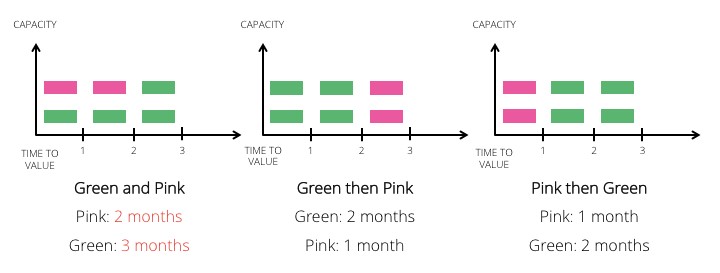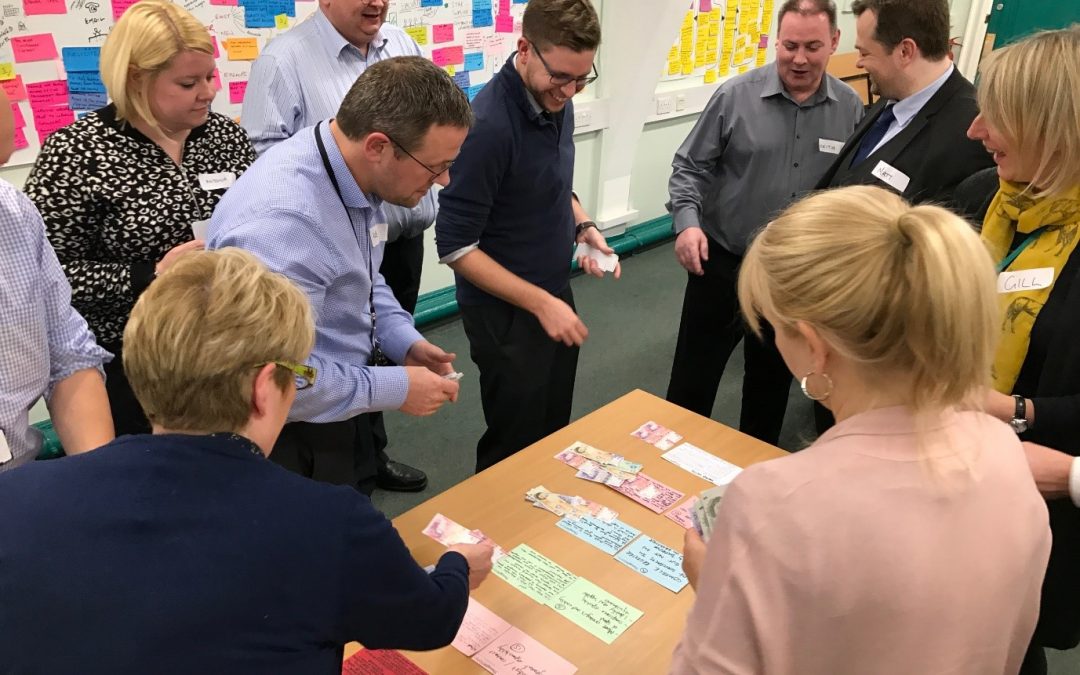Prioritisation is really about doing less of [what doesn’t matter] and doing more of [what does].
Why prioritise?
Prioritisation is important because by focusing on what is truly important to our users/customers we eliminate the creation of things that are undesired and not useful. The key concepts to remember are:
- the sooner the product is delivered,
- the sooner you can get feedback from users,
- the sooner you can improve it,
- and the sooner value is delivered to your customers and your business.
One key reason why prioritising works is the 80:20 rule (Pareto Principle): the 80/20 rule states that 80% of our typical activities contribute less than 20% to the value of our work. Therefore, if you only do the most valuable 20% of your activities you still get 80% of the value. So, the trick is finding the most valuable work.
Prioritising is about making choices of what to do and what not to do. To prioritise effectively you need to be able to recognise what is important, as well as to see the difference between urgent and important. Urgent activities require immediate attention; the important or high priority activities contribute to your mission, values, and goals. You’ll want to focus most of your energy on activities that are important but non-urgent. See Stephen R. Covey’s book – First Thing First and Time Management Matrix for further information.
Starting more is not better
The theory: Let’s say we have a Pink initiative which has 2 units of work and a Green initiative which has 4 units of work but the organisation/function/team only has the capacity to do 2 units of work at a time. The temptation is start both initiatives at the same time, however if you did that both initiatives would then take longer to deliver value. So ideally rather than start both at the same time, you should only start the project that is the most valuable, so you need to make the prioritisation call of what is going to deliver the most value; the Pink or Green Initiative.

There are always constraints – for example work is always limited by available capacity – see theory of constraints, bottleneck, queuing theory and Little’s Law for further reading. Prioritising helps you to manage your work within your constraints so that benefit realisation is optimised.
So prioritisation is good because it helps to manage constraints and deliver the most valuable thing(s) earlier – but generally for technology/software development it’s hard because there is always a backlog of work with competing goals, multiple stakeholders and vocal customers and users. So how do you work out what the priority is when lots of people need to be involved? Luckily there are lots of different prioritisation techniques which can help you…
Prioritisation techniques
At Thoughtworks and Stockport Council we use Agile and Lean methodologies, processes, practices and techniques to help us validate value quickly. My personal favourite is to focus on delivering Minimum Marketable Features (MMF) which is used with the an incremental funding methodology or defining a Minimum Viable Product (MVP) in order to validate hypotheses and assumptions as quickly as possible. I plot MMFs and MVPs in priority order on a Goal Oriented Product Roadmap.
MMFs and MVPs are used instead of trying to design and plan out all of the features that a system may need. As a team we agree the smallest, tightest possible definition of what people think is important and useful by prioritising the features and then delivering the product incrementally as quickly as possible.
I’ve listed many prioritisation techniques below which can help you to define your MMF or MVP:
- MoSCoW (Must, Should, Could, Would/Won’t)
- Financial analysis – Return On Investment (ROI), Net Present Value(NPV) or Internal Rate of Return (IRR)
- Matrices & Grids – Value Matrix, Wiegers Prioritization Matrix, Action Priority Matrix, Mitch Lacey Team Prioritisation, Priority= Urgency x Business Value , Eisenhower Priority Matrix, Prioritising Features, Total Experience Design Model, BCG Matrix, Theme Screening, How-Now-Wow Matrix, Value vs Complexity and Pain/Gain Decision-Making Model
- Dot voting
- Affinity Diagram/Clustering/Grouping – KJ Method
- User Story Mapping, another article on User Story Mapping, Walking Skeleton and Systemico Model
- Buy a Feature/Project (can play money or poker chips)
- Prune the product tree
- Whole Product Game
- Kano Model – UX Magazine Article and Jan Moorman: Measuring User Delight using the Kano Methodology
- Feature buckets
- Trade-off sliders – Project Success Sliders were initially created and devised by Rob Thomsett in his book, Radical Project Management.
- Atomise (AKA Work Breakdown Structure)
- Three Horizons of Growth
- Driver Diagram (AKA line of sight diagram)
- Calculations – Outcome-Driven Innovation (Opportunity Algorithm), Start-up Priorities, Breadth & Depth in Startup Metrics, Cost of Delay (CD3) and Weighted Shorted Job First
Try to use these techniques in a group workshop if possible or if you are working in a distributed team there are many online tools which can help you. The main thing is to agree the priorities collaboratively so that you can take advantage of wisdom of the crowds (2 minds are better than 1) and so that everyone has a shared understanding (avoid the HiPPO – Highest Paid Person’s Opinion dictating the priorities where possible).
A lot of these prioritisation techniques can be used at any level (see my onion diagram below), but some are better suited than others. I recommend that you give the prioritisation techniques a try and learn which ones work for you.

Experiment with different techniques
At Stockport Council we have been using and experimenting with a number of the techniques above, but when working at the product and strategy level my preferred method is to use a combination of Dot Voting and Buy a Feature to set the values which can then be entered into a matrix and mapped into a grid to visualise the results.
My personal favourite prioritisation grid has ‘Value’ on the y axis and ‘Effort’ or the x axis (see diagram below).

There are many other techniques that you can use to agree the values. Probably the most well-known method is Planning Poker using the modified Fibonacci Sequence. However with more mature teams you can spice it up by using other things as a proxy, for example different sizes of beer, but it’s also fun to create and agree your own as a team – I highly recommend using animals!
Alternatively, if you get bored of planning poker there are other techniques you can use to estimate like Affinity Estimating (AKA or bucket system) or Ordering protocol – The Challenge, Estimate, Override (CEO) and the Relative Mass Valuation are variations.
We’re also using Cost of Delay (CD3) and Weighted Shortest Job First (WSJF) at a portfolio level to decide on which initiative to start first. CD3 is calculated by adding the following values: User or Business Value + Time Criticality + Risk Reduction or Opportunity Enablement. I really like CD3 because it takes into account the Voice of Customer and Voice of Business.
WSJF is then calculated as the CD3 divided by Job Size which is a good proxy for complexity and duration. You will probably need to run several workshops with different audiences to get the values for the matrix, for example I usually run a workshop with the Delivery Team to get the Job Size and customers and representatives from different areas and levels of the business to get the User/Business Value score..
I like using CD3 and WSJF initially as opposed to more traditional financial analysis techniques as it avoids getting stuck in Benefit and Return on Investment (ROI) discussions and it also helps answer a different question: “Which is bigger, A or B?” not “How big is A?” This is much more useful for quick prioritisation.
We then use financial analysis to validate ROI with the top prioritised initiatives. An example of the CD3/WSJF Matrix is below:

These results are interesting because using CD3 you would start item A first however it is the last thing you would do using WSJF: A is actually the most valuable but also requires the most effort and therefore probably the longest thing. Conversely, item E has lowest value but is the lowest effort so has the highest WSJF, so most organisations would do this first to build momentum.
Ideally focus on CD3, but be aware it may take longer to achieve benefit realisation / ROI. If you have organisational capacity, you could start from the top of CD3 and WSJF simultaneously. Another interesting question that this raises is can the item A be broken down into smaller Items? See Atomise.
Top Ten Tips
- Talk to your customers – their input into the prioritisation process is vital.
- There are always constraints so prioritise things together to see different perspectives and to ensure a shared agreement and understanding. It also helps to drive ownership.
- There are lots of techniques and methods – give the techniques a try and learn which work for you; and then adapt for your circumstances.
- Initially use relative classification/scoring techniques so that you don’t get bogged down by exact values.
- If you need to get buy-in and/or build momentum use the WSJF calculation to define your low hanging fruit.
- If you’re serious about changing things – use CD3 calculation to find the things that deliver the most value.
- Remember, it’s ok to say “No.”
- Organise a regular (weekly or fortnightly) session to constantly prioritise based on changes from internal or external factors i.e. new information.
- Categorise things into themes and ensure alignment to vision and strategic goals.
- Don’t get stuck in analysis paralysis – make decisions quickly and then execute quickly. The sooner you start, the sooner you learn, the sooner you start to realise value.
Best of luck in your prioritisation endeavours.
Andy Birds
Thoughtworks Product Strategist

